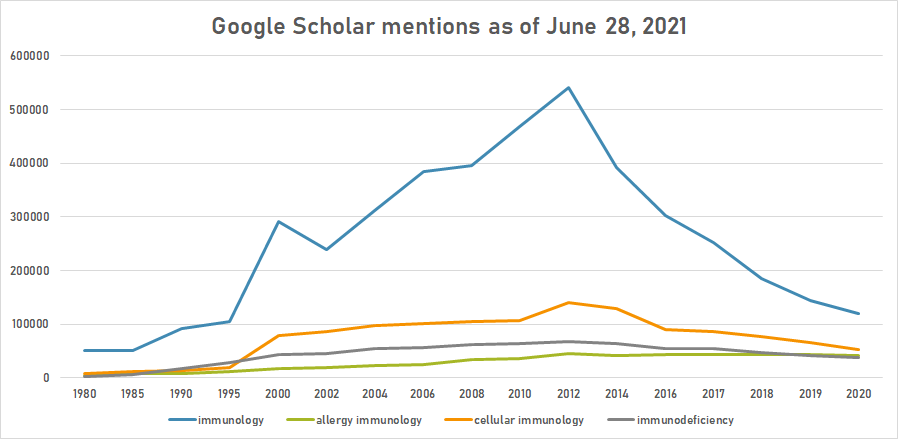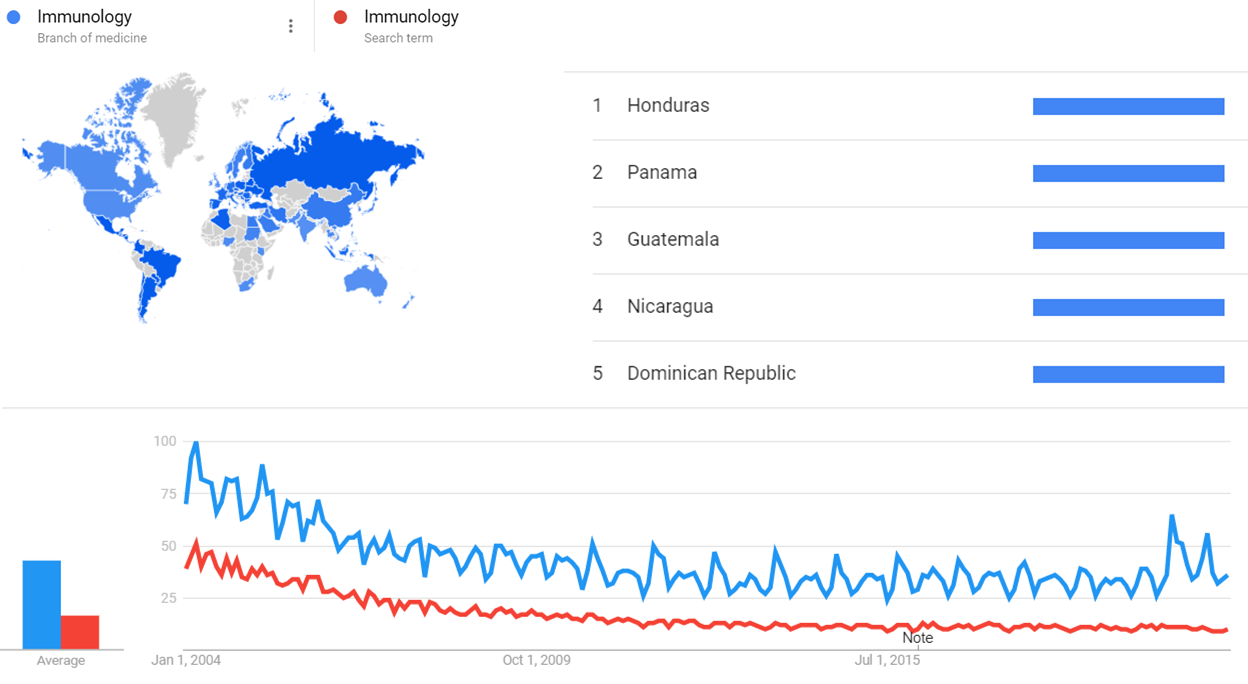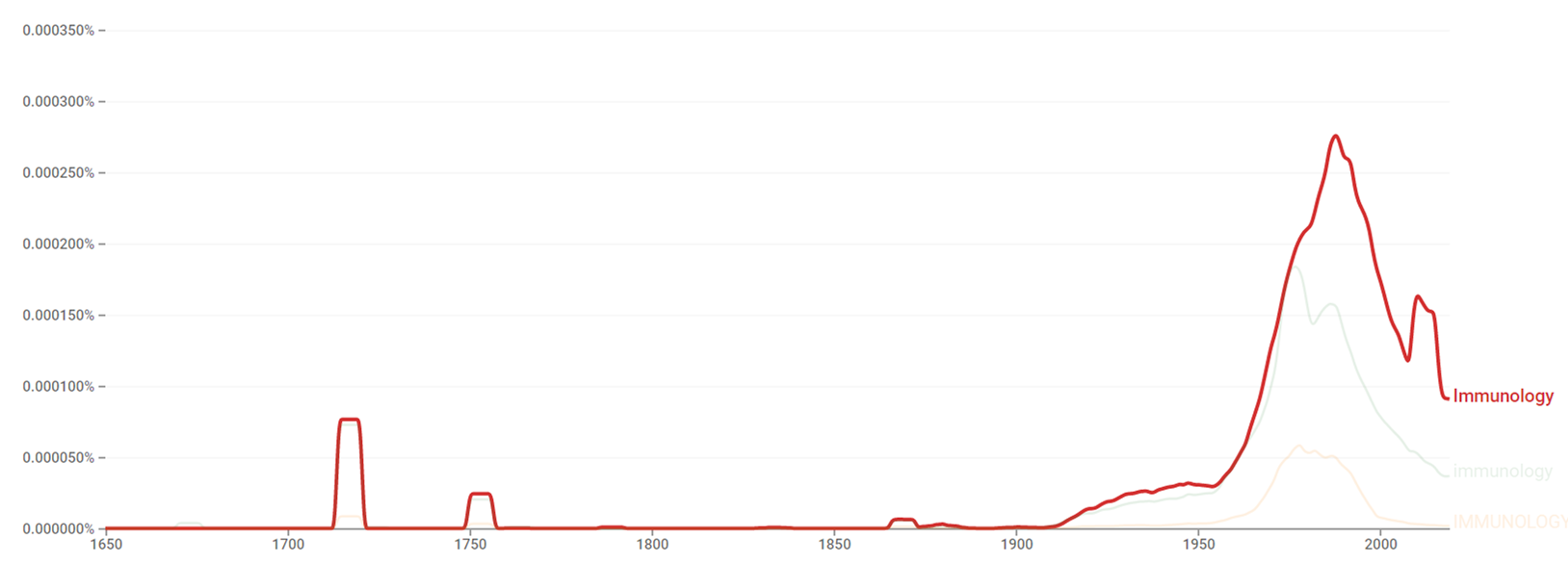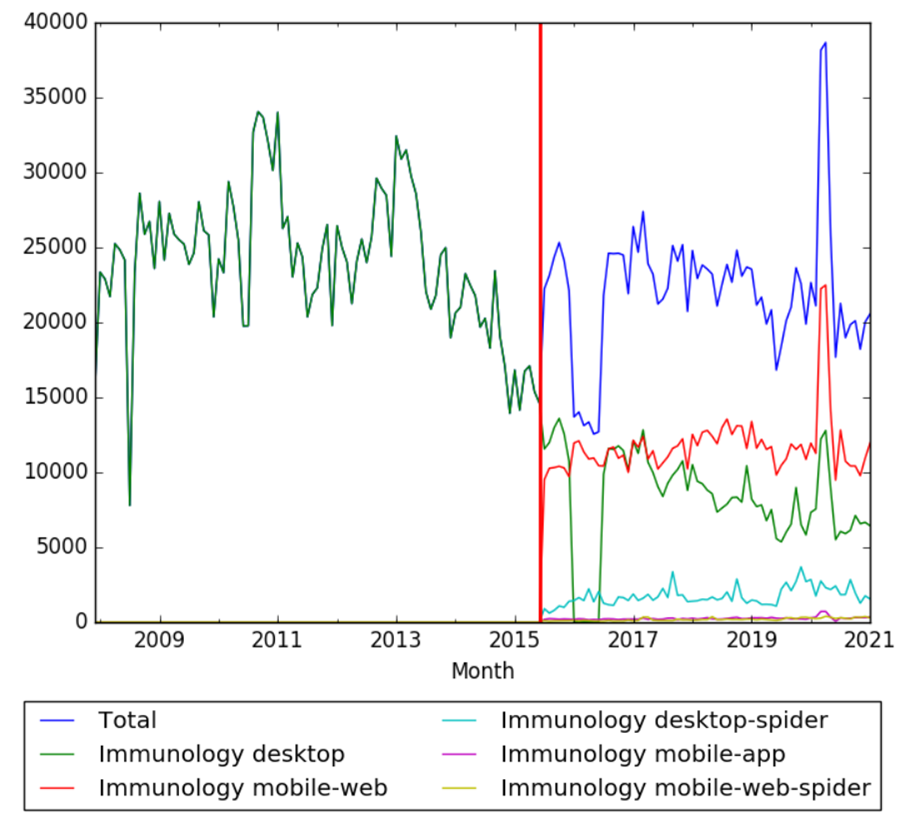Timeline of immunology
This is a timeline of immunology, attempting to describe important events in the development of the field. For a more focus on vaccines, visit Timeline of vaccines.
Big picture
| Time period | Development summary |
|---|---|
| 18th century | The early century sees interest in acquired immunity through the use of variolation as a prophylactic measure, whereby live virus is taken from a diseased smallpox victim and used as inoculum.[1] |
| 19th century | The modern era of immunization starts with the pioneering work of Edward Jenner, who discovers in 1796 that cowpox, or vaccinia, induces protection against human smallpox.[2] The century sees developments in immunology that include the recognition of phagocytosis and also mast cells.[1] 1884, Élie Metchnikoff proposes the cellular theory of immunology.[1] In the 1880s, Louis Pasteur devises a vaccine against cholera in chickens, and develops a rabies vaccine that proves a spectacular success upon its first trial in a boy bitten by a rabid dog. In 1890, Emil von Behring and Kitasato Shibasaburō discover that the serum of vaccinated individuals contain substances—which they call antibodies—that specifically bound to the relevant pathogen.[2] |
| 20th century | At the beginning of the 20th century, immunology remains a young discipline, with the humoral theory of immunity having strong influence, with long term implications for future immunological developments. In the 1950s, the idea of cell-mediated immunity is accepted and cellular immunity develops.[1] In the 1980s, scientists begin the rapid identification of genes for immune cells that continues to the present.[3] |
| 21st century | Today, immunology spreads across many biological disciplines. The most important areas of immunology currently include new strategies for vaccines and studies of regulatory T lymphocytes and the innate immune response. Fast-paced changes in immunology are also seen in pharmaceuticals.[4] |
Full timeline
| Year | Event type | Details | Country/region |
|---|---|---|---|
| 430 BC | Intimations already suggest that if one survives a disease, the person thereafter becomes "immune" to any subsequent exposures.[3] | ||
| c.980 – 1037 | Scientific development | Persian polymath Avicenna proposes a theory for acquired immunity.[1] | |
| 1546 | Scientific development | Italian physician Girolamo Fracastoro proposes that epidemic disease is caused by transferable seed-like entities that are capable of transmitting infection by direct or indirect contact or without contact over long distances. Fracastoro also applies this theory to smallpox and acquired immunity, although he wrongly believes that this immunity protects against infection by other diseases, such as measles.[1] | Italy |
| 1700 | Medical development | A procedure for immunization becomes established in China. The technique is called variolation, derived from the name of the infective agent—the variola virus.[3] | China |
| 1798 | Medical development | English physician Edward Jenner pioneers smallpox vaccination.[3][5][6][7] | |
| 1840 | Scientific development | German physician Friedrich Gustav Jakob Henle proposes a germ theory of disease.[8][9][10] | |
| 1862 | Scientific development | German biologist Ernst Haeckel recognizes phagocytosis.[6][7] | Germany |
| 1874 | Scientific development | German chemist Moritz Traube and Richard Gscheidlen inject micro-organisms into the blood and find that micro-organisms are rapidly destroyed and bloodstream maintain its sterility.[6] | Germany |
| 1877 | Scientific development | German Jewish physician Paul Ehrlich first describes mast cells.[11][3][6][7] | |
| 1883 | Scientific development | Russian zoologist Ilya Ilyich Mechnikov theorizes that cells are involved in the defense of the body. Metchnikoff introduces the concept of cell-mediated or cellular immunity.[3][5][12][7] | |
| 1884 | Scientific development | W. Grohmann notes that cell-free serum is capable of killing microorganism in vitro.[6] | |
| 1888 | Scientific development | French bacteriologists Pierre Paul Émile Roux and Alexandre Yersin discover bacterial toxin, by isolating a toxin secreted by corynebacterium diphtheriae and showing that the toxin—and not the microorganism—gives rise to the symptoms of diphteria.[13][6][7] | France |
| 1888 | Scientific development | American-British bacteriologist George Nuttall inoculates defibrinated blood with bacteria and shows that outside the body, serum retains its bactericidal activity.[6][7] | |
| 1889 | Scientific development | German bacteriologist Hans Ernst August Buchner first identifies a principle in fresh blood that he terms as "alexin" and is capable of killing bacteria.[6] | |
| 1889 | Scientific development | German bacteriologist Richard Friedrich Johannes Pfeiffer conducts a series of experiments that allow the understanding of bactericidal action of serum.[6] | Germany |
| 1891 | Scientific development | Robert Koch discovers delayed type hypersensitivity.[3][5][7] | |
| 1894 | Scientific development | Richard Pfeiffer discovers the phenomenon of bacteriolysis.[7] | |
| 1900 | Scientific development | Paul Ehrlich theorizes about some of the events taking place in immune cells, postulating that cells interact with toxins via "side chains" that stem from protoplasm.[6][7] | |
| 1900 | Scientific development | Austrian biologist Karl Landsteiner discovers ABO blood group system.[6] | |
| 1902 | Scientific development | Charles Richet coins the term anaphylaxis to describe the most dangerous allergic reaction.[5][6][7] | |
| 1903 | Scientific development | British bacteriologists Almroth Wright and Stewart Douglas discover opsonins.[14][15][7] | United Kingdom |
| 1904 | Scientific development | Julius Donath and Karl Landsteiner describe the role of antiself red blood cell antibodies in the pathogenesis of paroxysmal cold hemoglobinuria.[16] | |
| 1906 | Scientific development | Austrian scientist Clemens von Pirquet coins the term allergy.[3][5][6][7] | |
| 1907 | Scientific development | Swedish scientist Svante Arrhenius coins the term immunochemistry.[5][6] | |
| 1910 | Scientific development | English pharmacologist Henry Hallett Dale identifies histamine, a body chemical responsible for many allergic reactions.[17][18] | United Kingdom |
| 1910 | Scientific development | Peyton Rous develops his viral immunology theory.[7] | |
| 1915 | Journal | The Journal of Immunology is first published by The American Association of Immunologists.[19] | United States |
| 1916 | Medical development | American immunologist Robert Cooke and Albert Vander Veer report having successfully immunized patients allergic to a variety of grasses, including orchard grass, June grass, and sweet vernal grass.[20] | United States |
| 1917 | Scientific development | Austrian scientist Karl Landsteiner publishes results of an exhaustive study of haptens, contributing greatly to the knowledge of antigen-antibody reactions.[21][22][23][24][6][7] | |
| 1921 | Scientific development | Carl Prausnitz and Heinz Küstner discover that components in the blood can reproduce food allergy reactions.[5][6] | |
| 1924 | Scientific development | Ludwig Aschoff adopts the term reticuloendothelial system (RES).[6][25][26][7] | |
| 1926 | Scientific development | American bacteriologist Lloyd D. Felton isolates pure antibody preparation.[6] | |
| 1930 | Scientific development | Elvin Kabat for the first time reports that gamma globulin, also called immunoglobulin, of serum acts as an active component and is mainly responsible for immunological activity after infection.[6][12] | |
| 1930 | Scientific development | Friedrich Breinl and Felix Haurowitz propose the instructional theory, based on the protein folding hypothesis. According to this theory, the specificity of the antibody is determined by the antigen that provides a template to fold the antibody around itself.[12] | |
| 1934 | Scientific development | British pathologist John Marrack advances the antigen-antibody binding hypothesis.[6] | |
| 1936 | Scientific development | British immunologist Peter Alfred Gorer identifies the H-2 antigen in mice.[6] | |
| 1937 | Scientific development | Italian pharmacologist Daniel Bovet, working at Pasteur Institute, becomes the first to describe the activity of antihistamines.[27][28][29][30] | France |
| 1938 | Scientific development | John Marrack expounds the antigen-antibody binding hypothesis.[31][3] | |
| 1940 | Scientific development | Austrian biologist Karl Landsteiner and American scientist Alexander S. Weiner identify Rh antigens.[6] | |
| 1940 | Scientific development | Ilya Ilyich Mechnikov's hypothesis that the main cause of immunity in the immunized animals is active cells rather than the serum components is strengthened by the experimental proof given by Merrill Chase.[12] | |
| 1941 | Scientific development | American immunologist Albert Coons initiates a major revolution in immunology and cell biology for developing a technique for labeling specific antibodies with fluorescent dyes.[32] Coons and his collaborators first describe the possible use of fluorescent antibody for the detection of antigens in situ.[33][34] | |
| 1942 | Scientific development | Hungarian born American immunologist Jules Freund and Katherine McDermott publish a paper on their experiments on immunization of guinea pigs with horse serum containing killed tubercle bacilli and adjuvant.[35] Their paper is generally considered to be a landmark in immunology.[36][3] | |
| 1943 | Journal | The monthly peer-reviewed medical journal Annals of Allergy, Asthma & Immunology is established.[37] | United States |
| 1944 | Scientific development | British biologist Peter Medawar develops the immunological hypothesis of allograft rejection.[3] | |
| 1948 | Scientific development | Astrid Fagraeus demonstrates the production of antibodies in plasma B cells.[3] | |
| 1948 | Scientific development | George Snell develops congenic strains of mice.[38][3][39] | |
| 1949 | Scientific development | Australian scientists Frank Macfarlane Burnet and Frank Fenner hypothesize that developing antigen-reactive cells are susceptible to tolerance induction.[16][40][3] | Australia |
| 1949 – 1957 | Scientific development | British biologist Peter Medawar and Frank Macfarlane Burnet discover how the immune system rejects or accepts organ transplantation, and develop the immunological tolerance hypothesis, which is created as a platform for developing methods of transplanting solid organs.[31] | |
| 1950 | Scientific development | Howard Gershon and Koichi S. Kondo discover suppressor T cells.[6] | |
| 1953 | Scientific development | J.F. Riley and G.B. West first report localization of histamine in mast cells.[41][42][43] | |
| 1953 | Scientific development | The Graft-versus-host disease is first described.[7] | |
| 1953 | Scientific development | British scientists Rupert E. Billingham, Leslie Brent, and Peter Medawar demonstrate the induction of immunological nonresponsiveness by injecting neonatal mice with foreign cells.[16] | United Kingdom |
| 1953 | Scientific development | The immunological tolerance hypothesis is developed.[7] | |
| 1953 – 1978 | Scientific development | Michael Heidelberg and Oswald Avery show that polysaccharides of pneumococcus are antigens, enabling to show that antibodies are proteins.[31] | |
| 1956 | Scientific development | Niels Kaj Jerne, David Talmage and Frank Macfarlane Burnet develop the clonal selection hypothesis, which proposes that before a lumphocyte ever encounters an antigen, the lymphocyte has specific receptors for that antigen on its surface.[31] | |
| 1956 – 1961 | Scientific development | Baruj Benacerraf, Jean Dausset, and George Davis Snell discover genetically-determined structures on the cell surface that regulate immunological reactions.[44][45][46][31] | |
| 1957 | Scientific development | British virologist Alick Isaacs and Suiss colleague Jean Lindemann discover interferon.[47][3][48][7] | |
| 1957 | Scientific development | German-American immunologist Ernest Witebsky and Noel Rose publish the initial description of antiself antibodies, leading to an autoimmune disease (Hashimoto's thyroiditis).[16] | United States |
| 1958 – 1962 | Scientific development | American biologist Gerald Edelman and British biochemist Rodney Robert Porter discover human leukocyte antigens and antibody structure, thymus involvement in cellular immunity and T and B cell cooperation in immune response.[31][7] | |
| 1958 | Scientific development | French immunologist Jean Dausset discovers the first human protein that allows the body's immune system to distinguish its own cells from foreign cells.[49][50][51] | |
| 1959 | Scientific development | British biochemist Rodney Robert Porter discovers the antibody structure.[7] | |
| 1959 | Scientific development | British immunologist James Learmonth Gowans discovers lymphocyte circulation.[7] | United Kingdom |
| 1959 | Scientific development | Danish immunologist Niels Kaj Jerne, American immunologist David Talmage, and Australian virologist Frank Macfarlane Burnet develop clonal selection theory.[3] | |
| 1962 | Scientific development | Rodney Robert Porter proposes a basic four-chain model for immunoglobulin molecules.[3][52][53][54] | |
| 1962 | Scientific development | Team led by Australian scientist Jacques Miller discovers thymus involvement in cellular immunity.[3][7] | |
| 1962 | Scientific development | Noel Warmer and Alexander Szenberg in Australia, and Max Cooper in the United States, experimenting with chicken, are able to report that the bursa and the thymus are responsible for different immunological functions.[55][56][57][3] | Australia, United States |
| 1963 | Literature | British immunologist Robin Coombs publishes Clinical Aspects of Immunology (1963), which contains his famous classification of allergic reactions, adopted worldwide.[58] | |
| 1967 | Scientific development | Japanese immunologists Teruko Ishizaka and Kimishige Ishizaka identify immunoglobulin E (IgE), the allergy antibody.[59][60][61][62] | |
| 1968 | Scientific development | Anthony Davis and team discover T cell and B cell cooperation in immune response.[63][3] | |
| 1972 | Scientific development | The structure of the antibody molecule is revealed.[7] | |
| 1974 | Scientific development | Rolf M. Zinkernagel and Peter C. Doherty discover how the immune system recognizes virus-infected cells.[3] | |
| 1974 | Journal | Journal Immunogenetics launches.[19] | |
| 1975 | Scientific development | Cesar Milstein, Georges J.F. Köhler and Niels K. Jerne develop theories concerning the specificity in development and control of the immune system and the discovery of the principle for production of monoclonal antibodies. This discovery would lead to an enormous expansion in the exploitation of antibodies in science an medicine.[31][7] | |
| 1976 | Scientific development | Japanese scientist Susumu Tonegawa discovers a genetic principle for generation of antibody diversity.[31][7] | |
| 1980 | Journal | The American Journal of Reproductive Immunology is launched.[64] | United States |
| 1980 | Journal | Peer-reviewed academic journal Human Immunology is launched.[65] | United States |
| 1985 | Scientific development | Susumu Tonegawa and American biologist Leroy Hood identify immunoglobulin genes.[3] | |
| 1986 | Journal | The International Reviews of Immunology is first published.[66] | |
| 1988 | Journal | The Journal of Acquired Immune Deficiency Syndromes is first published.[19] | |
| 1990 | Scientific development | American biologist Leroy Hood identifies genes for the T-cell receptor.[67][3] | |
| 1990 | Medical development | Gene therapy for severe combined immunodeficiency (SCID) is developed.[7] | |
| 1994 | Scientific development | French immunologist Polly Matzinger develops the "danger" model of immunological tolerance.[7] | |
| 1995 | Scientific development | Japanese immunologist Shimon Sakaguchi discovers regulatory T cells.[7] | Japan |
| 1996 – 1998 | Scientific development | Toll-like receptors are identified.[7] | |
| 2000 | Medical development (drug) | United States Food and Drug Administration approves the first anti-IgE drug, rhu-MAb-E25.[68][69] | |
| 2001 | Journal | Monthly review journal Nature Reviews Immunology is released by Nature Publishing Group.[19] | United Kingdom |
Numerical and visual data
Google Scholar
The following table summarizes per-year mentions on Google Scholar as of June 28, 2021.
| Year | immunology | allergy immunology | cellular immunology | immunodeficiency |
|---|---|---|---|---|
| 1980 | 51,500 | 4,600 | 7,600 | 1,600 |
| 1985 | 51,600 | 7,840 | 10,700 | 5,530 |
| 1990 | 92,200 | 7,280 | 14,200 | 17,500 |
| 1995 | 105,000 | 11,000 | 18,600 | 27,900 |
| 2000 | 291,000 | 17,300 | 78,900 | 43,700 |
| 2002 | 238,000 | 18,800 | 85,800 | 45,800 |
| 2004 | 311,000 | 23,100 | 97,300 | 53,800 |
| 2006 | 384,000 | 24,300 | 101,000 | 56,600 |
| 2008 | 395,000 | 34,800 | 104,000 | 61,100 |
| 2010 | 468,000 | 36,000 | 107,000 | 63,400 |
| 2012 | 540,000 | 44,800 | 141,000 | 67,200 |
| 2014 | 392,000 | 41,000 | 129,000 | 63,400 |
| 2016 | 303,000 | 43,800 | 89,100 | 54,600 |
| 2017 | 252,000 | 44,100 | 86,500 | 54,400 |
| 2018 | 185,000 | 44,200 | 76,700 | 47,700 |
| 2019 | 143,000 | 42,700 | 64,700 | 42,000 |
| 2020 | 120,000 | 41,700 | 52,000 | 37,700 |

Google Trends
The comparative chart below shows Google Trends data Immunology (Branch of medicine) and Immunology (Search Term), from January 2004 to February 2021, when the screenshot was taken. Interest is also ranked by country and displayed on world map.[70]

Google Ngram Viewer
The chart below shows Google Ngram Viewer data for Immunology, from 1650 to 2019.[71]

Wikipedia Views
The chart below shows pageviews of the English Wikipedia article Immunology, on desktop from December 2007, and on mobile-web, desktop-spider, mobile-web-spider and mobile app, from July 2015; to January 2021.[72]

Meta information on the timeline
How the timeline was built
The initial version of the timeline was written by User:Sebastian.
Funding information for this timeline is available.
Feedback and comments
Feedback for the timeline can be provided at the following places:
- IMMUNOLOGY Facebook group
- Microbiology & Immunology Research Facebook group
- Immunotherapy Support Group Facebook group
What the timeline is still missing
Timeline update strategy
See also
External links
References
- ↑ 1.0 1.1 1.2 1.3 1.4 1.5 Doherty, Michelle; Robertson, Morag J. "Some early Trends in Immunology".
{{cite journal}}: Cite journal requires|journal=(help) - ↑ 2.0 2.1 "Basic Concepts in Immunology".
{{cite journal}}: Cite journal requires|journal=(help) - ↑ 3.00 3.01 3.02 3.03 3.04 3.05 3.06 3.07 3.08 3.09 3.10 3.11 3.12 3.13 3.14 3.15 3.16 3.17 3.18 3.19 3.20 3.21 3.22 "History of immunology". encyclopedia.com. Retrieved 1 August 2018.
- ↑ "Immunology: Attacking a Moving Target". sciencemag.org. Retrieved 27 August 2018.
- ↑ 5.0 5.1 5.2 5.3 5.4 5.5 5.6 Rejaunier, Jeanne; Freund, Lee. The Complete Idiot's Guide to Food Allergies.
- ↑ 6.00 6.01 6.02 6.03 6.04 6.05 6.06 6.07 6.08 6.09 6.10 6.11 6.12 6.13 6.14 6.15 6.16 6.17 6.18 6.19 6.20 6.21 6.22 Sinha, J.K.; Bhattacharya, S. A Text Book of Immunology.
- ↑ 7.00 7.01 7.02 7.03 7.04 7.05 7.06 7.07 7.08 7.09 7.10 7.11 7.12 7.13 7.14 7.15 7.16 7.17 7.18 7.19 7.20 7.21 7.22 7.23 7.24 7.25 7.26 7.27 7.28 patil, C.s. Biotechnology.
- ↑ Taylor, Milton W. Viruses and Man: A History of Interactions.
- ↑ Ben-Menaḥem, Ari. Historical Encyclopedia of Natural and Mathematical Sciences, Volume 6.
- ↑ Zaccheo, Aleardo; Palmaccio, Eleonora; Venable, Morgan; Locarnini-Sciaroni, Isabella; Parisi, Salvatore. Food Hygiene and Applied Food Microbiology in an Anthropological Cross Cultural Perspective.
- ↑ McCance,, Kathryn L.; Huether, Sue E. Pathophysiology E-Book: The Biologic Basis for Disease in Adults and Children.
{{cite book}}: CS1 maint: extra punctuation (link) - ↑ 12.0 12.1 12.2 12.3 Kumar, Arvind. Textbook of Immunology.
- ↑ "Alexandre Yersin". britannica.com. Retrieved 3 August 2018.
- ↑ Mims, Cedric A. The War Within Us: Everyman's Guide to Infection and Immunity.
- ↑ Scientific American, Volume 184.
- ↑ 16.0 16.1 16.2 16.3 Moticka, Edward J. A Historical Perspective on Evidence-Based Immunology.
- ↑ Biomedical Aspects of Histamine: Current Perspectives (Nancy Khardori, Rahat Ali Khan, Trivendra Tripathi ed.).
- ↑ Kaliner, Michael A. Rhinitis, An Issue of Immunology and Allergy Clinics - E-Book.
- ↑ 19.0 19.1 19.2 19.3 "Medical Journals Recommended by Neil Gerardo". mrx.com. Retrieved 29 August 2018.
- ↑ Mitman, Gregg. Breathing Space: How Allergies Shape Our Lives and Landscapes.
- ↑ Stevens, Chrstine Dorresteyn; Miller, Linda E. Clinical Immunology and Serology: A Laboratory Perspetive.
- ↑ Kay, Lily E. The Molecular Vision of Life: Caltech, the Rockefeller Foundation, and the Rise of the New Biology.
- ↑ Silverstein, Arthur M. A History of Immunology.
- ↑ Kreier, Julius P.; Mortensen, Richard F. Infection, resistance, and immunity.
- ↑ Martinez, A. Julio. "The Role of the Reticuloendothelial System in Infections of the Central Nervous System". link.springer.com. Retrieved 3 August 2018.
- ↑ Friedman, Herman. The Reticuloendothelial System: A Comprehensive Treatise Volume 5 Cancer.
- ↑ "Daniel Bovet". britannica.com. Retrieved 7 August 2018.
- ↑ Lemke, Thomas L.; Williams, David A. Foye's Principles of Medicinal Chemistry.
- ↑ Dudley, Joel; Berliocchi, Laura. Drug Repositioning: Approaches and Applications for Neurotherapeutics.
- ↑ Schwartzman, David. Innovation in the Pharmaceutical Industry.
- ↑ 31.0 31.1 31.2 31.3 31.4 31.5 31.6 31.7 Ben-Menaḥem, Ari. Historical Encyclopedia of Natural and Mathematical Sciences, Volume 3.
- ↑ Development of Sea Urchins, Ascidians, and Other Invertebrate Deuterostomes: Experimental Approaches.
- ↑ Antibody Techniques (Vedpal S. Malik, Erik P. Lillehoj ed.).
- ↑ Biomembrane Frontiers: Nanostructures, Models, and the Design of Life (Thomas Jue, Subhash H. Risbud, Marjorie L. Longo, Roland Faller ed.).
- ↑ Freund, Jules; McDermott, Katherine (1942). "Sensitization to horse serum by means of adjuvants". Proceedings of the Society for experimental Biology and Medicine. 49 (4): 548–553.
- ↑ Bhattacharya, Soumen; Sinha, Jayanta (2006). "Box 1.1 Important Landmarks of Immunology". A Text Book of Immunology. Academic Publishers. p. 7.
- ↑ "Welcome to the Annals 2018: New and improved? Time will tell". annallergy.org. Retrieved 9 August 2018.
- ↑ Artzt, Karen. "Mammalian Developmental Genetics in the Twentieth Century". doi:10.1534/genetics.112.146191. PMC 3512133. PMID 23212897.
{{cite journal}}: Cite journal requires|journal=(help) - ↑ The Major Histocompatibility System in Man and Animals (D. Götze ed.).
- ↑ Cruse, Julius M.; Lewis, Robert E. Atlas of Immunology, Third Edition.
- ↑ Popat N, Patil. Discoveries In Pharmacological Sciences.
- ↑ Histamine and Anti-Histaminics: Part 1: Histamine. Its Chemistry, Metabolism and Physiological and Pharmacological Actions.
- ↑ Heubner, Wolfgang; Eichler, Oskar; Born, Gustav V. R. Handbook of experimental pharmacology.
- ↑ Cruse, Julius M.; Lewis, Robert E. Atlas of Immunology, Third Edition.
- ↑ Mehra, Narinder K. The HLA Complex in Biology and Medicine: A Resource Book.
- ↑ Leroy, Francis. A Century of Nobel Prize Recipients: Chemistry, Physics, and Medicine.
- ↑ Erling, Norrby. Nobel Prizes And Nature's Surprises.
- ↑ "Interferon Discoverer Dies". the-scientist.com. Retrieved 3 August 2018.
- ↑ MAIENSCHEIN, Jane. Whose View of Life?.
- ↑ "Jean Dausset (1916–2009)". onlinelibrary.wiley.com. Retrieved 9 August 2018.
- ↑ Miller, Dean. Geneticists.
- ↑ Roitt, Ivan Maurice; Brostoff, Jonathan; Male, David K. Immunology.
- ↑ Lövgren, Ulf. Enzyme immunoassay in combination with liquid chromatography for sensitive and selective determination of drugs in biosamples.
- ↑ The Grolier Library of Science Biographies: D'abano-Flamsteed.
- ↑ Szentivanyi, Andor; Friedman, Herman. The Immunologic Revolution: Facts and Witnesses.
- ↑ Desowitz, Robert S. Thorn in the Starfish: The Immune System and How It Works.
- ↑ Hospital Practice, Volume 2, Issues 1-6. HP Publishing Company.
- ↑ Richmond, Caroline. "Robin Coombs". PMC 1482389.
{{cite journal}}: Cite journal requires|journal=(help) - ↑ Rejaunier, Jeanne; Freund, Lee. The Complete Idiot's Guide to Food Allergies.
- ↑ Textbook of Allergy for the Clinician (Pudupakkam K. Vedanthan, Harold S. Nelson, Shripad N. Agashe, Mahesh P A, Rohit Katial ed.).
- ↑ Johansson, S.G.O. "The discovery of IgE".
{{cite journal}}: Cite journal requires|journal=(help) - ↑ Jackson, Mark. Allergy: The History of a Modern Malady.
- ↑ "immunology history IV". keratin.com. Retrieved 9 August 2018.
- ↑ "2018 - Volume 80, American Journal of Reproductive Immunology". onlinelibrary.wiley.com. Retrieved 9 August 2018.
- ↑ "A New Day for Human Immunology". journals.elsevier.com. Retrieved 9 August 2018.
- ↑ "INTERNATIONAL REVIEWS OF IMMUNOLOGY". periodicals.com. Retrieved 9 August 2018.
- ↑ Davis, Daniel M. The Beautiful Cure: Harnessing Your Body’s Natural Defences.
- ↑ "Genentech and Novartis Submit Application for FDA Approval of Anti-IgE Antibody". gene.com. Retrieved 3 August 2018.
- ↑ "Drug Profile: Xolair". discoverymedicine.com. Retrieved 3 August 2018.
- ↑ "Immunology". Google Trends. Retrieved 28 February 2021.
- ↑ "Immunology". books.google.com. Retrieved 28 February 2021.
- ↑ "Immunology". wikipediaviews.org. Retrieved 28 February 2021.